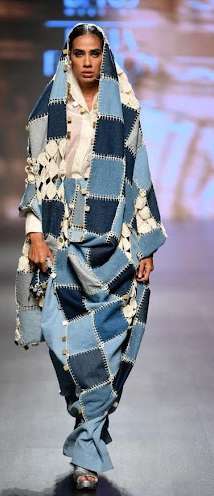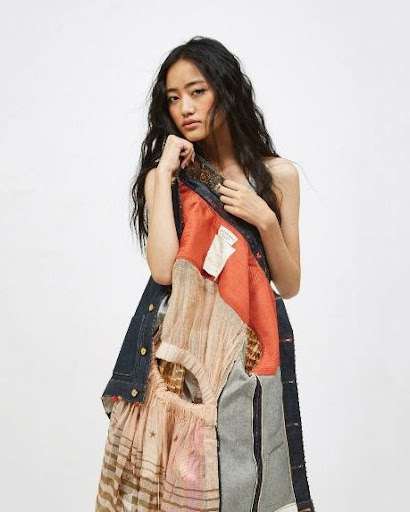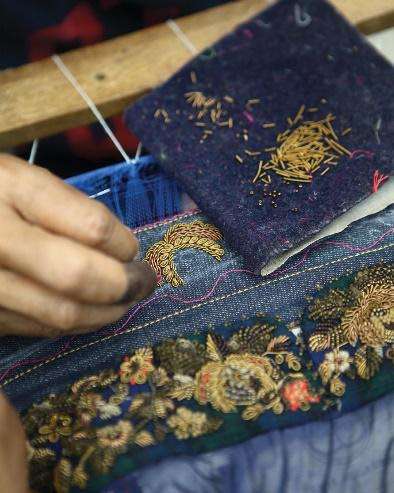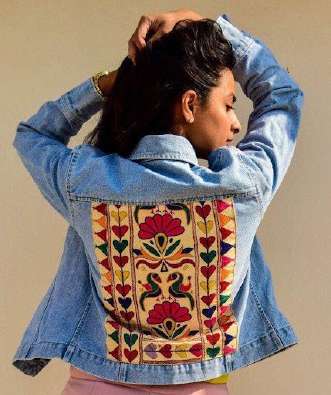 AMALGAMATION OF DENIM WITH INDIAN CRAFTS AND TEXTILES
AMALGAMATION OF DENIM WITH INDIAN CRAFTS AND TEXTILES
If we throw this question – is there a more versatile textile other than denim in history? There pops rarely any name, but denim! Ever since the discovery of this extraordinary woven textile, it has never gone out of fashion. The silhouettes might have taken drastic curves on the graph of trends, but the denim was never categorised as a fad. It is not only extremely versatile in terms of the number of garments, but all areas of fashion and culture around the world. It has the quality of blending with other fibres, fabrics and textiles very effortlessly. The twill weave fabric has certainly become the comfort food of fashion. From everyday wear to red carpet couture looks, it is widely accepted in forms, shapes, weights, weaves, blends, washes. Never in history is a textile so much experimented with and yet does not lose its identity. Today for example, if we see a denim Kurti, we would call it denim before we could call it a Kurti. The long list of Indian textiles gives so much scope for denim to create never-ending fresh styles if amalgamated. The simplicity of denim is a perfect contrast to our intrigue designs and motifs. Indian couture designers are known for experimenting with our textiles, embroideries, dyeing and printing techniques with different blends of denim so effortlessly that the first glance at it screams ‘denim can be desi also! ‘The whole concept of desi denim has evolved with time. The article is to shed light upon these fusions and understand where denim is heading along with Indian textiles together.
 Despite not being a piece of our nation’s customs and culture, a pair of blue denim pants has come to address numerous things in contemporary India. For some it’s a question of plain solace, a go-to article of clothing for when you’re venturing out; for other people, it’s an image of trust, of an advanced India where sexual orientation jobs are gradually dissolving into many shades of progress. For some purposes, it’s a characteristic of unscrupulousness and there are the individuals who trust it’s a nostalgic token of India’s prospering indigo economy. Throughout the long term, and all the more so as of late, India has opened up toward the western world and the tendency towards the western way of dressing – which has consistently continued in the nation and has developed dramatically. The shift towards denim has been seen because of different reasons, including the developing youth populace and mainstream society impact – a portion of the principal factors behind the nation’s design upheaval.
Despite not being a piece of our nation’s customs and culture, a pair of blue denim pants has come to address numerous things in contemporary India. For some it’s a question of plain solace, a go-to article of clothing for when you’re venturing out; for other people, it’s an image of trust, of an advanced India where sexual orientation jobs are gradually dissolving into many shades of progress. For some purposes, it’s a characteristic of unscrupulousness and there are the individuals who trust it’s a nostalgic token of India’s prospering indigo economy. Throughout the long term, and all the more so as of late, India has opened up toward the western world and the tendency towards the western way of dressing – which has consistently continued in the nation and has developed dramatically. The shift towards denim has been seen because of different reasons, including the developing youth populace and mainstream society impact – a portion of the principal factors behind the nation’s design upheaval.
 Perhaps the greatest trigger for this change in patterns was the presentation of satellite digital TV in India in the mid-90s, which brought standard western amusement and news to India which fundamentally impacted the young people of the time most. As cell phones keep on penetrating further into more modest urban communities and towns, the country has progressively been presented toward the western world and this has introduced an adjustment of the two insights just as inclinations. This has most certainly made it advantageous for denim. I think the receptiveness to adjust to change among individuals comes more from the western culture, films, big names, web-based media forces to be reckoned with, and so forth Individuals need to look great and feel better. Denim’s utilisation as an all-climate and evergreen piece of attire for all (men, ladies and even kids) assisted it with standing out enough to be noticed and made an enormous market that had never occurred for some other garment prior.
Perhaps the greatest trigger for this change in patterns was the presentation of satellite digital TV in India in the mid-90s, which brought standard western amusement and news to India which fundamentally impacted the young people of the time most. As cell phones keep on penetrating further into more modest urban communities and towns, the country has progressively been presented toward the western world and this has introduced an adjustment of the two insights just as inclinations. This has most certainly made it advantageous for denim. I think the receptiveness to adjust to change among individuals comes more from the western culture, films, big names, web-based media forces to be reckoned with, and so forth Individuals need to look great and feel better. Denim’s utilisation as an all-climate and evergreen piece of attire for all (men, ladies and even kids) assisted it with standing out enough to be noticed and made an enormous market that had never occurred for some other garment prior.
 Online business and social media have drastically supported the development of denim in the country, particularly in coordinated classification. While the admittance to brands and limits has opened up another field for consumers, it has likewise been instrumental in furnishing brands with a vigorous stage that guarantees both openness and infiltration to distant areas.
Online business and social media have drastically supported the development of denim in the country, particularly in coordinated classification. While the admittance to brands and limits has opened up another field for consumers, it has likewise been instrumental in furnishing brands with a vigorous stage that guarantees both openness and infiltration to distant areas.
Online business organisations drove the best change in the retail business. In a hurry, shopping has turned into a well-known pattern; purchasers have simple admittance to an assortment of items online rather than truly visiting a store. Organisations have been utilising online media stages as a special instrument as they are the most advantageous and least expensive method for correspondence. Denim is a high development class in the home-grown clothing market. The Indian denim market is displaying persistent development throughout the long term. With innovations, patterns and higher markets come, this area has promising development potential. Indeed, even in country areas, denim is turning out to be profoundly popular with most men and young person young ladies selecting denim wear over conventional outfits.
So normally, the area is constrained to oblige an area of brands, each with its strength. This makes the denim market in India exceptionally cutthroat. In addition, the denim wear market in India is amazingly divided, which has additionally prompted expanded contests.
India’s promising buyer environment in recent years has paved the way for probably the greatest brands in the denim world and their prosperity has consistently tempted others to investigate the changes in the more settled Indian waters. Right now, the Indian customers are at standard with their worldwide friends. They are much more advanced with their shopping decisions and are continually looking for curiosity in encounters. So, to oblige this insightful customer base, local brands are constrained to pay their game. Advancement is a compulsion by changing inclinations of consumers towards solace, brands have begun making inventive materials, remembering non-abrasiveness, weightlessness, stretchability, adaptability, solidness, and so forth For a style that was the consequence of our developing interest with the West, denim has without a doubt penetrated the Indian market and shake things up in unbelievable ways. Overcoats, shirts, aircraft, saris—there’s nothing denim doesn’t offer. Specialists today are in any event, utilising denim as a material for their speciality, clearing the way for an entire age of youthful originators who are exploring different avenues regarding this texture in eco-accommodating, reasonable, and exceptional ways. Throughout the long term, denim has become seasonless and exceptionally flexible as far as its wearability and solace. With enormous improvements in innovation, denim is not any more limited to its toughness. Today a couple of denim can look tasteful with a touch of sheen, feel graceful to give you that quill contact feeling, can look tough however can be adaptable, can act like weaves and still look and wash like denim. The market today has been refreshed with progressive denim items regularly.
 During the time spent arrangement how native artworks of Indian and denim take part in an extramarital entanglement, it will be uncalled for to not begin by concentrating on youthful originators and brands who have accomplished amazing work that is interesting in its own sort. The denim 11.11 utilisations hand-spunKala cotton, local to Kutch, and it needs barely anything to – practically no water to develop. The coarse texture is utilised to fix regular staples of any popular millennial’s closet: tunics, shirts, kurtas, jeans and dresses. A scope of native methods — Kalamkari, ajrakh, bandhani are utilised as embellishments. The textures are coloured with regular vegetable dyes. The current denim patterns don’t do without maintainability. Regardless of whether it is interwoven, upcycling old pants, innovative example making, someplace maintainability is gradually becoming equivalent to exemplary woven texture denim. More denim marks are tending to its natural effect (each pair utilises about 1,600 gallons of water) by bringing practical other options. New Delhi-based Korra, established by ShyamSukhramani, Himanshu Shani, Rajesh Jaju and Mia Morikawa is another stunning illustration of our theme. Sukhramani uncovered “We utilise just crude denim which is unwashed and produced using natural cotton. Our strings are produced using 100% natural cotton and all the metalware is metal.”
During the time spent arrangement how native artworks of Indian and denim take part in an extramarital entanglement, it will be uncalled for to not begin by concentrating on youthful originators and brands who have accomplished amazing work that is interesting in its own sort. The denim 11.11 utilisations hand-spunKala cotton, local to Kutch, and it needs barely anything to – practically no water to develop. The coarse texture is utilised to fix regular staples of any popular millennial’s closet: tunics, shirts, kurtas, jeans and dresses. A scope of native methods — Kalamkari, ajrakh, bandhani are utilised as embellishments. The textures are coloured with regular vegetable dyes. The current denim patterns don’t do without maintainability. Regardless of whether it is interwoven, upcycling old pants, innovative example making, someplace maintainability is gradually becoming equivalent to exemplary woven texture denim. More denim marks are tending to its natural effect (each pair utilises about 1,600 gallons of water) by bringing practical other options. New Delhi-based Korra, established by ShyamSukhramani, Himanshu Shani, Rajesh Jaju and Mia Morikawa is another stunning illustration of our theme. Sukhramani uncovered “We utilise just crude denim which is unwashed and produced using natural cotton. Our strings are produced using 100% natural cotton and all the metalware is metal.”
 If we skirt these new present-day plan intercessions, at first denim was promoted with a blend of banjara create, that is the point at which the entire idea of melding denim with something Indian was conceived. Intensely weaved denim coats were the go-to boho looks of different Indian superstars. Swaroop by Swati Bhatia normally works on getting out Indian on denim. The plans have Indian folklore motivated canvases on denim coats, we could likewise see banjara weaving in her plan mediations. Architects across the globe and extraordinarily India use denim as a material to feature different sorts of craftsmanship. Surface embellishments are one of their cherished strategies. The number of weavings that would effortlessly this material is as per the following; Kantha, banjara, phulkari, reflect work, Sindhitaropa, zardozi. With regards to weavings and embellishments, something less investigated is the arrangements of the themes and craftsmanship. It is ideally dark burdens or pockets. As of late, however, we can see contemporary denim coats by Korra, where they play the entire outlines of coats and try different things with customary style denim pockets.
If we skirt these new present-day plan intercessions, at first denim was promoted with a blend of banjara create, that is the point at which the entire idea of melding denim with something Indian was conceived. Intensely weaved denim coats were the go-to boho looks of different Indian superstars. Swaroop by Swati Bhatia normally works on getting out Indian on denim. The plans have Indian folklore motivated canvases on denim coats, we could likewise see banjara weaving in her plan mediations. Architects across the globe and extraordinarily India use denim as a material to feature different sorts of craftsmanship. Surface embellishments are one of their cherished strategies. The number of weavings that would effortlessly this material is as per the following; Kantha, banjara, phulkari, reflect work, Sindhitaropa, zardozi. With regards to weavings and embellishments, something less investigated is the arrangements of the themes and craftsmanship. It is ideally dark burdens or pockets. As of late, however, we can see contemporary denim coats by Korra, where they play the entire outlines of coats and try different things with customary style denim pockets.
Creative pattern making is an altogether different and novel plan of intercessions. Even though it is to a great extent investigated all around the world yet, how denim unfurls into Indian native outlines is something admirably interesting and new to the denim market of plan melange. Indian materials are utilised in an assortment of courses as far as situations and interwoven designs denim. Patchwork is a huge way of legitimising the word amalgamation, which is significantly noticeable even to a layman.
 Indian customary pieces of clothing like kalidar lehengas, choli pullover with zardozi, kurtas, saree amazingly, yet Indian architects have been inventive enough to drape different contemporary variants of half saree on denim.
Indian customary pieces of clothing like kalidar lehengas, choli pullover with zardozi, kurtas, saree amazingly, yet Indian architects have been inventive enough to drape different contemporary variants of half saree on denim.
The brand urban drape is exceptionally roused by denim surfaces and tones. Every one of their sarees is propelled by a comparable idea. The join tie and colour, bandhani and so on cotton-based textures provide the saree with a look of denim, generally coloured in indigo. However, a visual combination of one’s surface into duping a texture using Indian dyeing techniques could be an intercession.
To have different viewpoints of Indian textiles from denim’s perspective we tried to incorporate some issues that have become serious in this pandemic, and this amalgamation could probably bring out solutions. The artisan community have experienced nightmare during this lockdown along with everyone else. They lost their livelihood, which will now take months to resume, unlike other corporate jobs. There are some dying crafts of India, which will be even more difficult to restrain now. But surprising the retail garment sector of fashion has not seen such a downward graph in the pandemic. People are shopping for jeans and t-shirts like they always used to. After identifying this gap within the fashion industry, we propose a solution to bridge this difference in the market demand of Indian textiles and crafts. For consumers, a pair of jeans will always be a pair of jeans that is their comfortable fit. Even after we add or subtract certain elements, the demand or consumer behaviour around it won’t change. Taking advantage of this market scenario, we could use fast fashion or retail brands in denim wear and convert them to be a little more sustainable by incorporating small portions of textiles from dying crafts.
Taking the help of pattern making in the amalgamation of denim and Indian textiles would help us make Indian crafts more feasible for the masses. Small portions of the garment can be used to add swatches, such as back pockets on jeans, cuff details on a denim jacket, drop shoulder jackets with himroo sleeves. Creative ways could be explored by patchwork. Due to the use of fewer textiles, ready-to-wear brands will not have to invest a lot, but artisans will get a commission in bulk. It’s time that all fashion producers take responsibility for Indian crafts being extinct and not only a few designers to worry about it and create conscious denim collections. It is our collective responsibility and we must share it in our ways. Denim is a textile that has given us the never-ending scope of experiment and it will take ages for us to run out of ideas while working with this versatile woven textile. Denim has been a part of all classes of fashion, be it couture, workwear, casual, etc. by amalgamating it with Indian handlooms and crafts we are presenting an opportunity for it to also be a part of the heritage group of fashion partially. Soon there will be a category of heritage denim that will be embellished with Parsi Gara and zari work.
In this globalised period, the denim wear section in India, in the same way as other conventional item portions, is going through a shocking difference in insight just as advancement. With India’s extending economy, blasting utilisation, urbanising populace, and developing working class pay, denim wear has a gigantic potential and freedom to develop. Until a couple of years prior, denim was famous in the metropolitan urban communities just, nonetheless, it has now bit by bit become well known in the semi-metropolitan and country advertise too. Developing mindfulness and an expanding liking for worldwide style have prompted this turn of events. Apparent shift towards western wear in the Tier – II, III and – IV business sectors is a key development driver of denim wear in India. A huge youth populace with rising extra cash and mindfulness towards design will catalyse the development of denim wear in the country.
 Denim is evergreen! It holds a splendid future in India in the years to come. Furthermore, we can barely comprehend its development once the lovely and rich specialities of India are fused. Yet, the rivalry is high in this area and development is an impulse. Brands and planners should continually enhance with innovation and the texture for solace, strength and manageability. Simple availability, assortment and keeping a serious valuing point is essential to be on top of brains. It is likewise basic for brands to concentrate on the developing business sector, changing shopper inclinations and designs and consolidate this knowledge when dealing with the bigger brand development system.
Denim is evergreen! It holds a splendid future in India in the years to come. Furthermore, we can barely comprehend its development once the lovely and rich specialities of India are fused. Yet, the rivalry is high in this area and development is an impulse. Brands and planners should continually enhance with innovation and the texture for solace, strength and manageability. Simple availability, assortment and keeping a serious valuing point is essential to be on top of brains. It is likewise basic for brands to concentrate on the developing business sector, changing shopper inclinations and designs and consolidate this knowledge when dealing with the bigger brand development system.
